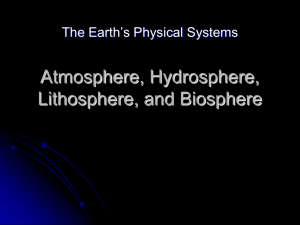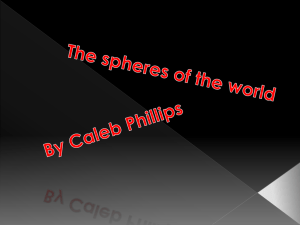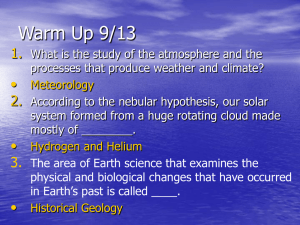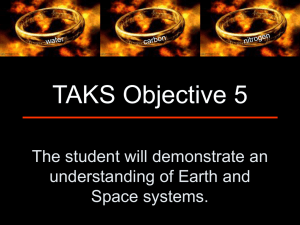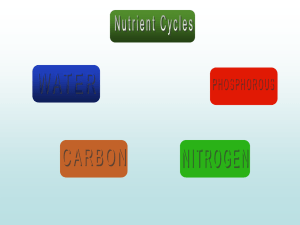The lithosphere (silicon dioxide)
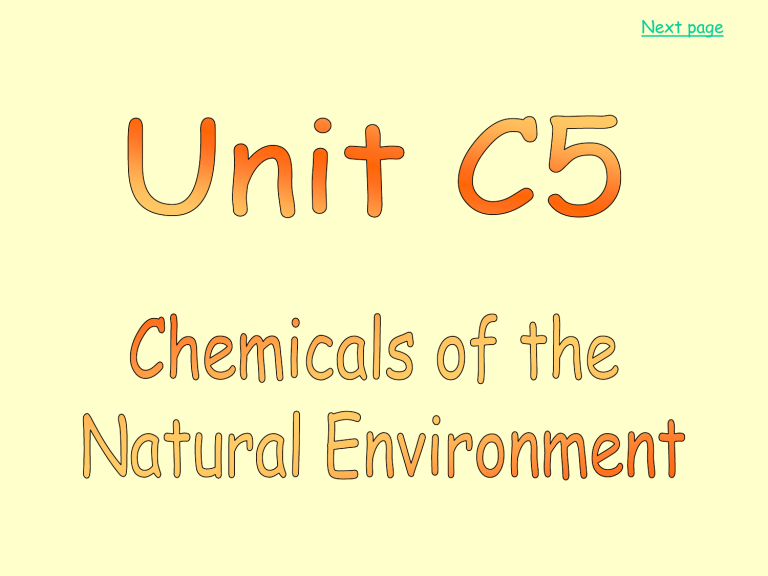
Next page
The topics in this unit are:
Next page
1 – Spheres of the earth
2 – The atmosphere
3 – The atmosphere (molecules)
4 – The atmosphere (bonding)
5 – The hydrosphere
6 – The hydrosphere (the sea)
7 – The lithosphere (elements)
8 – The lithosphere (silicon dioxide)
9 – The lithosphere (silicon dioxide properties)
10 – The biosphere
11 – Extracting metals
12 – Extracting metals (displacement)
13 –Extracting metals (electrolysis)
14 – Electrolysis of aluminium oxide
Spheres
The Earth is made up of four different spheres.
Next page lithosphere hydrosphere atmosphere biosphere
The Atmosphere Next page
The atmosphere is a layer of gas surrounding the Earth.
It contains the elements nitrogen, oxygen and argon
It contains some compounds, carbon dioxide and water vapour
The chemicals that make the atmosphere are non-metal
elements or molecular compounds of non-metals
The Atmosphere 2 Next page
The molecules in the atmosphere are gases because they have low boiling points.
Chemical
Oxygen
Nitrogen
Carbon dioxide
Water vapour
Argon
Formula
O
2
N
2
CO
2
H
2
O
Ar
Diagram
O=O
Mass Boiling point
(16x2) 32 -182.9ºC
(14x2) 28 -195.8ºC
O=C=O (16x2)+12 44 -78ºC
H-O-H (1x2) +16 18
Ar
100ºC
40x1 40 -185.8ºC
What is the relationship between boiling point and mass?
The Atmosphere - Bonding Next page
The molecules in the atmosphere covalently bonded.
This means that there is a shared pair of electrons between the molecules
Shared pair of electrons
Each atom has a full outer shell
-oxygen has claim to 8 electrons
-Each hydrogen has claim to 2 electrons
The Hydrosphere
The hydrosphere is to do with water on the Earth.
Next page
Water is an unusual molecule.
Its special properties are
-It is a liquid. Has a small mass so we would expect it be a gas
-It can dissolve ions in it
-It becomes less dense as it becomes a solid
-Pure water does not conduct
The Hydrosphere
The hydrosphere is mainly made of the seas.
Sea water is salty. Why?
Next page
The main soluble chemical carried into the sea is sodium chloride. Sea water tastes salty because the concentration of salt has built up over millions of years.
The Lithosphere Next page
The lithosphere is the crust and upper mantle.
Element
Oxygen, O
Silicon, Si
Aluminium, Al
Iron, Fe
Calcium, Ca
Magnesium, Mg
Sodium, Na
Potassium, K
Titanium, Ti
Hydrogen, H
Abundance
455000
272000
83000
62000
46600
27640
22700
18400
6320
1520
The most common elements are O, Si and Al
Some compounds found in the lithosphere are used as
gemstones because they are
rare and have a shiny appearance .
.
The Lithosphere – Silicon Dioxide Next page
A lot of the silicon and oxygen in the crust is present as
silicon dioxide.
In silicon dioxide, SiO
2
, each silicon atom forms a covalent bond to four oxygen atoms and each oxygen atom forms a covalent bond to two silicon atoms.
Instead of forming small molecules, they form a giant structure (lattice) that goes on and on. The Si-O bond is very
strong and so the structure is very
strong and rigid.
The Lithosphere – Silicon Dioxide Next page
Properties of silicon dioxide are:
It has a high melting point and boiling point
This is because of the strong covalent bonds
It is an electrical insulator
This is because there are no free ions
Insoluble in water
This is because there are no charges to attract water molecules
The Biosphere Next page
The biosphere contains three groups of molecules
-carbohydrates, proteins and DNA
Chemicals in the biosphere are mainly made of carbon,
hydrogen and oxygen.
Extracting Metals Next page
Metals are found in the ground as ORES. The metal combined with another element (commonly oxygen).
The metal must be separated from the other element.
There are two methods to extract a metal and it depends on the reactivity of the metal. Displacement with carbon or electrolysis
Metals below carbon are extracted using displacement
Metals above carbon are extracted using electrolysis
Extracting Metals - Displacement Next page
A more reactive element will displace a less reactive element.
For example:
Zinc Oxide + Carbon Zinc + Carbon Dioxide
Zinc has been reduced
Carbon has been oxidised
Extracting Metals - Electrolysis Next page
Metals that are more reactive than carbon will not be displaced by it. Electrolysis must be used.
Electrolysis is splitting up ionic
compounds by passing electricity through them.
The solution we are splitting up must be molten so that the ions are free to
move.
One electrode is positively charged
(anode) and one is negatively charged
(cathode).
When current is passed through, positive ions move to the cathode and negative ions move to the anode
Extracting Metals – Electrolysis of Aluminium
Next page
Aluminium oxide is dissolved in cryolite to lower the melting point.
Aluminium oxide is made into a liquid so the ions can move
Aluminium ions move to the cathode and form pure aluminium metal
Oxide ions move to the anode and form bubbles of oxygen gas.

